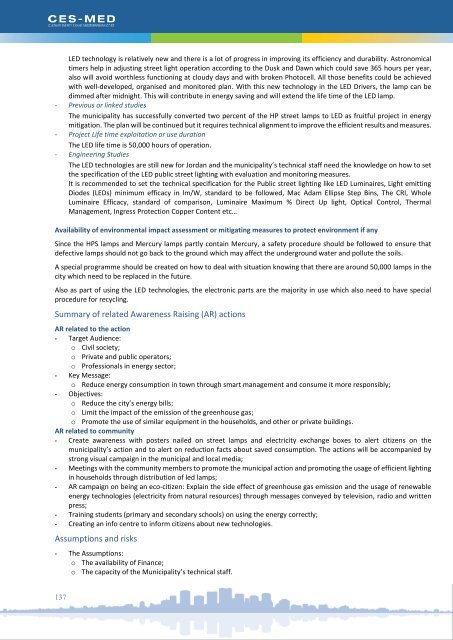171117_SECAP of Greater Irbid Municipality_SET_rev2
Create successful ePaper yourself
Turn your PDF publications into a flip-book with our unique Google optimized e-Paper software.
especially those that will impact<br />
performance <strong>of</strong> technical<br />
requirements (temperature, wind<br />
speed, and geological hazards).<br />
- Further assessment <strong>of</strong> anticipated electricity tariff undertaken.<br />
- Financial analysis carried out. Preliminary financing planned.<br />
- Project implementation plan developed.<br />
- Options agreements for land access (where required) secured.<br />
- Evaluation and concept <strong>of</strong> the commercial structure <strong>of</strong> the project<br />
and project company(s) carried out.<br />
- While the accuracy <strong>of</strong> satellite data is increasing and is acceptable in many cases, it is <strong>of</strong>ten desirable to implement<br />
site-specific measurements <strong>of</strong> irradiation3 as early in the project planning process as possible; the feasibility study<br />
stage is a good time to bring such data into the planning process. Note that irradiation levels <strong>of</strong>ten vary across seasons,<br />
and this needs to be accounted for in the financing model.<br />
- Electrical cabling design and single line diagrams.<br />
- Electrical connections and monitoring equipment.<br />
- Grid connection design, including transformers and metering, etc.<br />
- Full energy yield analysis using screened solar data and the optimised layout.<br />
- Assessment <strong>of</strong> all technology options and cost/benefit analysis <strong>of</strong> potential suppliers given the project location,<br />
including:<br />
o Module selection. This is an optimized selection based on the feasibility phase output, current availability, and<br />
pricing in the market place. Note that in countries where the solar industry is still in its infancy, there may be<br />
challenges when importing solar modules and other critical components <strong>of</strong> plant infrastructure. Examples include<br />
delays at customs and difficult negotiations on the terms <strong>of</strong> sale with manufacturers lacking a local sales<br />
representative or distributor.<br />
o Inverter selection. Manufacturers are predominately based in Europe and North America, though others are<br />
emerging in China and Japan. As above, importation can result in delays to project schedules.<br />
o Mounting frame or tracking system selection, including consideration <strong>of</strong> site specific conditions.<br />
1. PERMITTING AND ENVIRONMENTAL, HEALTH AND SAFETY (EHS) REQUIREMENTS<br />
- Detailed review and inventory <strong>of</strong> all necessary permits and licences needed for constructing and operating the power<br />
plant. Examples are environmental permits, land use permits, and generator licences.<br />
- Pre-application discussions with the relevant consenting authority about the schedule for permitting, to understand<br />
the financial implications.<br />
- Detailed review <strong>of</strong> environmental and social considerations, such as wildlife conservation or other designations that<br />
may affect permissible activities at the project sites; this is usually performed with a desk based assessment and if<br />
possible supplemented by an initial site survey.<br />
- Initial consultation with key stakeholders, including local community stakeholders, as relevant.<br />
- Grid connection issues. This should be a more detailed assessment <strong>of</strong> likelihood, cost, and timing <strong>of</strong> grid connection,<br />
as well as transmission line capacities and constraints. This may also include submission <strong>of</strong> an initial application into<br />
the grid interconnection queue or achieving a “feasibility stage tariff” approval from the regulator<br />
2. FINANCIAL FEASIBILITY OF PROJECT<br />
- Financial modelling to determine commercial viability and attractiveness <strong>of</strong> the project. Such modelling includes all<br />
costs and revenues. It should also involve a sensitivity analysis to start assessing the project risks.<br />
- Further assessment <strong>of</strong> the anticipated electricity tariff. This is especially pertinent in markets where the tariff is<br />
expected to fluctuate, either by:<br />
o Deliberate design, such as in a power market where the developer is an Independent Power Producer (IPP) selling<br />
power in a wholesale or spot exchange;<br />
o Market forces, such as use <strong>of</strong> Renewable Energy Credits (RECs) or another market-based instrument, which could<br />
contribute to the developer’s revenue; or<br />
o Potential for revision <strong>of</strong> negotiated tariffs, such as if the government decides to revise the tariffs retroactively<br />
(uncommon but has occurred) or the <strong>of</strong>f-taker asks for re-negotiation.<br />
130

















